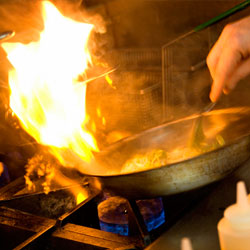Home Fire Safety
Home Fire Safety
Kingston Fire & Rescue Services is dedicated to fire prevention by:
- Conducting fire inspections to make sure that all required fire prevention and safety measures are in place and being maintained.
- Consulting with businesses, organizations and event planners to ensure they understand the fire safety and prevention measures associated with their enterprises.
- Educating the public regarding fire safety and prevention measures.
Use the links below to learn how to best protect yourself and those you care about from the risk of fire.
Practice Safe Candle Use
As the popularity of candles brings an increase in fires started by candles, Kingston Fire & Rescue Services is urging everyone to practice safe candle use.
According to the National Candle Association, 7 out of 10 North American households use candles. At the same time, National Fire Protection Association research shows that candles are a common cause of home fires. In recent years, candle fires in the home were responsible for an estimated 190 civilian deaths, 1,450 civilian injuries and $265 million in property damage. Four out of ten candle fires start in the bedroom and one in six start in common rooms, living rooms, family rooms or dens. Nearly half the people killed by candle fires in the home were younger than 20; children ages 5 to 9 accounted for a disproportionate share of the victims, with a candle-fire death rate 2.5 times higher than the general population.
Rules for safe candle use:
- Never leave burning candles unattended; always extinguish candles before leaving the room, leaving the house or going to bed.
- Keep candles away from items that can catch fire, such as clothing, books, paper, curtains, Christmas trees, or decorations.
- Keep burning candles out of the reach of children and pets.
- Place candles on stable furniture in sturdy holders that won't tip over and are big enough to collect dripping wax.
- Don't place lit candles in windows where they could ignite blinds or curtains.
- Extinguish taper and pillar candles when they get within two inches of the holder or decorative material. Extinguish votive and filled candles before the last half-inch of wax starts to melt.
- Avoid candles with imbedded combustible materials or decorative holders that could ignite.
- NEVER allow children or teens to have candles in their bedrooms.
Cottage Fire Safety
Just like your home, your cottage or cabin must have working smoke alarms on every storey. It's the law.
- Pack a smoke alarm with fresh batteries when heading to a hunting camp, trailer, or cabin.
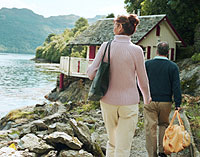
- Clear brush and debris from around the structure. Make sure the roof is clean and there are no overhanging branches.
- Have all chimneys cleaned and inspected every year. Heating systems should be inspected at least annually by a qualified technician.
- Allow the ashes from your woodstove or fireplace to cool before emptying them into a metal container with a tight-fitting lid. Store the container outside.
- Propane refrigerators any fuel fired appliances may produce carbon monoxide. Install a carbon monoxide alarm in your recreational property.
- Make sure the entrance to the property has a clearly visible sign indicting the property number.
- Check with Kingston Fire & Rescue for open air burning restrictions.
- When an outdoor burning ban is implemented, no outdoor fires are permitted.
Electrical Safety
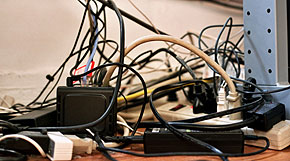 Check cords for damage such as fraying or nicks. A damaged cord can expose wires and result in a potential shock or fire hazard.
Check cords for damage such as fraying or nicks. A damaged cord can expose wires and result in a potential shock or fire hazard.- Avoid running cords under rugs, which can damage the cord and cause a fire.
- Extension cords should be used only as a temporary connection. If permanent wiring is required, have additional outlets installed by a licensed electrician. Extension cords should not be linked together - instead, use an extension cord that is long enough to do the job.
- Avoid overloading a circuit with 'octopus outlets'. If additional outlets or circuits are required, have them installed by a licensed electrician.
- A cord or plug that becomes hot is an indication of an overloaded circuit.
- Air conditioners, space heaters, and other heavy appliances should be plugged directly into an outlet. If this is not possible, use a 14 gauge three-wire, grounding-type appliance extension cord.
- When replacing a fuse, make sure it is of the right amperage. Substituting a higher amp fuse where a smaller one is required can pose a fire hazard.
Holiday Safety
The following safety tips will help to keep you and your family safe during the holiday season.
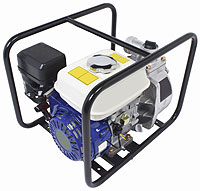
- Keep your tree fire free. Buy a fresh tree and keep the base of the trunk in water at all times. Lit candles should never be placed on or near the Christmas tree.
- Check all sets of lights before using them. Discard any light sets that are damaged or old. Make sure that you use the proper lights for the environment — indoor sets for inside the house and outdoor sets for outside the house.
- Stay in the kitchen when cooking. Unattended cooking is the leading cause of kitchen fires.
- Keep candles in a sturdy holder away from children, pets, and combustible materials. Blow candles out before leaving the room.
- Alcohol and fire are a dangerous mix. Do not attempt to cook or smoke while under the influence of alcohol.
- Encourage smokers to smoke outside.
- Install smoke alarms on every storey and outside sleeping areas. For added protection, install a smoke alarm in each bedroom. Test smoke alarms monthly.
- Smoke alarms, carbon monoxide alarms and fire extinguishers make excellent gifts.
Home Escape Planning
Home escape plans are often referred to as EDITH — Exit Drills In The Home.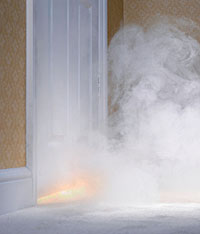
- Learn how to make your own home escape plan.
- Install smoke alarms on every storey and outside sleeping areas. It's the law.
- In case a fire starts, everyone should know two ways out of every room, if possible. When the smoke alarm sounds, everyone must know what to do and where to go. Develop and practice a home fire escape plan with the entire family.
- Determine who will be responsible for helping young children, older adults or anyone else that may need assistance.
- Check that all exits are unobstructed and easy to use.
- Know where to go. Choose a meeting place outside, such as a tree, a lamp post, or a neighbour's house where everyone can be accounted for.
- In case of fire, don't try to save possessions — go directly to your meeting place.
- If caught in smoke, get low and go under the smoke to the nearest safe exit.
- Call the fire department from outside the home, from a cell phone or a neighbour's home.
- Get out and stay out. Never re-enter a burning building.
Home Heating Safety
The high cost of home heating fuels and utilities have caused many people to search for alternate sources of home heating — namely portable space heaters. These methods of supplemental heating may be acceptable; however, they are a major contributing factor in residential fires. These fire safety tips can help you prevent fires and maintain a fire-safe home.
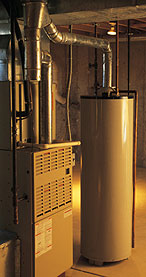
- Have your heating system examined annually by a qualified service technician to reduce the risk of fire and/or carbon monoxide poisoning.
- Install a CO alarm to alert occupants to the presence of deadly carbon monoxide gas.
- Creosote is a major cause of chimney fires. Have chimneys and flue pipes cleaned regularly and inspected at least once per year.
- Use a properly fitted fire screen around the fireplace.
- Watch for smoke coming into the room. This could indicate a blockage in the chimney or a faulty damper control mechanism.
- Allow the ashes from your woodstove or fireplace to cool before emptying them into a metal container with a tight-fitting lid. Keep the container outside.
- Give space heaters space: keep space heaters at least 3 feet away from anything that can burn, including curtains, upholstery, clothing and people.
Kitchen Safety
The number one cause of residential fires in North America is from cooking. Kingston Fire & Rescue offers the following fire safety tips to follow when cooking: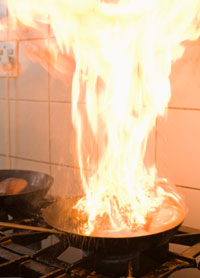
- Never leave cooking unattended. A stovetop fire can start in a flash - keep close watch on your cooking at all times.
- If a pot catches fire, slide a lid over the pot and turn off the stove. Never put water on a kitchen fire or try to move the pot to the sink. Always call the fire department.
- Wear tight fitting clothing or roll up your sleeves when using the stove to prevent accidental clothing fires.
- A fire extinguisher can be a useful safety item - if you know how to properly operate it. Use a multi-purpose, listed extinguisher on small, contained fires and never allow the fire to get between you and your exit.
- Clear all combustible items such as wooden or plastic cooking utensils, dishcloths, paper towels and pot holders from stove tops. These objects can easily ignite if they come in contact with a burner.
- If you burn yourself, immediately run cool water over the wound for several minutes. If the burn is severe, seek medical attention.
- Deep frying is a major kitchen hazard. Use only thermostatically controlled deep fryers to prevent overheating the oil and the chance of fire.
- Do not overload electrical outlets with appliances. Use heat-producing appliances away from cupboards, curtains, and other combustible items.
- Never attempt to cook while judgement is impaired or if you are under the influence of alcohol or drugs.
- It is the law in Ontario that all residences have working smoke alarms on every level and outside sleeping areas. Test smoke alarms monthly and change batteries when you change your clocks.
Space Heater Safety
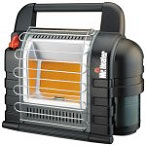
Space heaters are the leading cause of home fires during December, January and February — but such disasters can be prevented with a few simple precautions.
Have annual safety checks, inspections, and necessary repairs on all home heating equipment (including kerosene and gas space heaters) performed by qualified service technicians.
- Equip your home with a least one smoke alarm on each level and outside every sleeping area. Install a carbon monoxide (CO) detector in the hallway near every sleeping area of the home. Keep at least one fully charged multi-purpose, ABC-type fire extinguisher in the home at all times.
- Keep areas around heat sources free of papers and combustible materials. Store paints, solvents and flammable liquids away from all heat and ignition sources.
- Develop a fire-escape plan before a fire occurs. Be certain that all members of the household understand the plan and are able to carry out the plan in case of emergency. Be sure the plan includes a predetermined meeting place outside the house. If your clothing does catch fire, don't run! Stop. Drop down immediately, cover face with hands, and Roll to smother the flames.
- A space heater is a self-contained, free standing air heating appliance intended for installation in the space being heated and not intended for duct connection. Fuel-burning space heaters also can cause carbon monoxide poisoning and indoor air pollution because of improper venting or incomplete combustion.
- Choose a space heater that is either ULC or CSA approved. These heaters will have the most up-to-date safety features and the manufacturer will provide important use and care information to the consumer. An automatic cut-off device is required to turn off electric or kerosene heaters if they tip over. Buy a heater that is the correct size for the area you want to heat. The wrong size heater could produce pollutants and may not be an efficient use of energy.
- Select a space heater with a guard around the flame area or heating element. Place the heater on a level, hard and nonflammable surface, not on rugs or carpets or near bedding or drapes. Place heaters in areas where there is little chance someone will bump into it. Keep the heater at least three feet from bedding, drapes, furniture, or other flammable materials or liquids.
- Space heaters should be located in plain sight and clearly visible. Space heaters must be kept at least 3 feet away from any combustible material. Nothing should ever be placed on top of or touching a space heater and never use heaters to dry clothes or shoes.
- Keep doors open to the rest of the house if using an unvented fuel-burning space heater. This helps prevent pollutant build-up and promotes proper combustion. Follow the manufacturer's instructions to provide sufficient combustion air to prevent carbon monoxide build-up. Keep an outside window opened approximately an inch to insure adequate fresh air infiltration. This is true regardless of whether you use a kerosene heater or some other conventional method of heating, if your home is relatively new and tight, or if it is older but has been winterized to reduce air infiltration from the outside.
- Never leave a space heater on when going to sleep. Space heaters must always be turned off and unplugged when the area being heated is not occupied. Keep children and pets away from space heaters — the surface temperature of the heater may reach as high as 500 degrees Fahrenheit.
- Have gas and kerosene space heaters inspected annually and repaired by qualified technicians to ensure that they are clean and safe to operate. Keep the wick of the kerosene heater clean and properly adjusted. Appliances that are not working properly can release harmful and even fatal amounts of pollutants and carbon monoxide. Replace missing guards and controls at once. Never operate a defective heater. Read and follow the manufacturer's operating instructions. Keep the owner's manual in a convenient place to refer to when needed.
Hazards
Consumers should be aware of the hazards when buying and using gas, kerosene, and electric space heaters. Fires and burns may occur from contact with or close proximity to the flame, heating element, or hot surface area. Fires and explosions may be caused by flammable fuels or defective wiring. Indoor air pollution or carbon monoxide poisoning can be caused by improper venting or incomplete combustion of fuel-burning equipment.
Maintenance
Consult your operator's manual for instructions or recommended maintenance to ensure the heater's proper operation. Required maintenance should include periodically cleaning the unit, trimming the wick, cleaning off soot and carbon, inspecting for fuel leaks and procedures recommended by the manufacturer. If you suspect the heater is not working properly, extinguish it immediately and allow it to cool. Take it to a qualified service technician for repair.
An improperly operating heater can result in a fire or can generate an excessive amount of the byproducts of combustion: soot, carbon monoxide and sulphur dioxide. Always use the correct fuel for your heater.
Adequate ventilation is necessary for safe operation of the kerosene heater. Burning kerosene consumes oxygen and produces carbon dioxide, sulphur dioxide, nitrogen dioxide, carbon monoxide and other gases. Ventilation must be provided to replace oxygen as well as to remove gases in order to prevent asphyxiation or respiratory problems. The manufacturer's recommendations should be followed to provide adequate oxygen for combustion. In an energy efficient home, additional air intake may be necessary. The heater should never be used as the only heat source, except in an emergency situation. Do not leave a heater unattended.
